What To Know About GMO

By Lisa Jancarik
In a few years, Artic Granny Smith and Artic Golden Delicious apples, genetically modified not to brown over the course of an afternoon's snacking, will hit American supermarkets. These fruits have been engineered to eliminate the enzyme polyphenol oxidase, which causes browning. This engineered strain of apples is the first genetically modified food to be designed for purely aesthetic reasons. No genes have been added, only removed. The browning process isn't the same thing as rotting, the apple's developers explain, although consumers sometimes equate the two. So, these apples won't be mistaken for fresh if abandoned in the back of the produce drawer for a month.
Other solutions to the unappetizing browning of apple slices are already in use. For example, McDonald's currently uses the chemical antioxidant calcium ascorbate—widely used elsewhere in the food industry—to combat the same issue. Upon FDA approval, which would be considered a major coup for those who support genetically modified organisms (GMO), Artic apples will be labeled as genetically modified (GM) when they are sold. These apples will represent the most recent GM offering that is geared to consumers, rather than growers. If successful, Artic may work to bring similar brown-resistant GM foods, like pears and lettuce, to market.
Past: Consider the GM Tomato
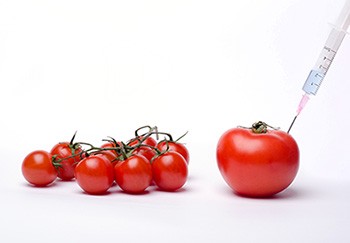
The debate over GMO has raged for some time. In 1994, Calgene's FlavrSavr tomato, the U.S.’s first commercially grown GM produce, was sold in stores as fresh produce. Calgene suppressed the gene for polygalactonuronase (PG), because some evidence in the 1980s suggested that the enzyme was a key factor in fruit softening. They hoped that suppressing the gene would allow a tomato to ripen on the vine before transport to the supermarket (many tomatoes today are picked while green and reddened using ethylene gas). Genetic suppression was achieved by inserting PG antisense DNA, and the resulting tomatoes generated as little as 1% of the PG found in typical supermarket tomatoes. After some field trials, the U.S. Department of Agriculture determined that these tomatoes were not a "plant-pest" and allowed field testing and transport. Monsanto eventually bought out Calgene, and shelved the FlavrSavr tomato—citing high production costs. Presently, there are no GM fresh tomatoes in the produce aisle.
In 1996, a puree of a different GM tomato reached British consumers. Between 1996 and 1999, Zeneca processed and sold 1.8 million cans of the paste, clearly labeled as made from genetically engineered tomatoes. Initially, the GM tomato paste, processed at significantly lower costs and sold at a lower retail price, outsold competing conventional tomato pastes at some grocery locations. U.K. consumers didn't seem concerned about genetically modified organisms until a Scottish study released in 1999 suggested that genetically modified potato strains were toxic to laboratory rats. By that time, the GM paste's sales had already declined, but shifting public opinion inspired grocery chains Safeway and Sainsbury to issue statements that their house brands would not include GM ingredients.
Present: Safety Concerns
The aforementioned 1999 Scottish study has since been much criticized, but it did draw attention to GMO and spark a debate that has taken a few different directions, and resulted in a flood of questionable facts and misinformation from both sides of the argument. The topic has become increasingly sensitive among U.S. and European consumers, although GM foods have entered the markets of several other countries, including Australia, Canada, India, Argentina and China, with very little backlash.
Opponents of genetically modified foods mainly question their safety, although most studies show that these foods are safe for human consumption. Experts generally acknowledge, however, that long-term effects remain unclear. Opponents of GM foods want more testing and regulation, citing concerns over the production of allergens or the transfer of antibiotic resistant genes to human gut flora. So far, the scientific literature has not yielded any substantial results to support these concerns.
The FDA generally acknowledges GM foods as safe. Meanwhile, the American Medical Association (AMA) has come out in favor of mandatory pre-market safety testing, a step not currently required by U.S. regulators. On the international scene, the World Health Organization (WHO) reports that no ill health effects from GMO have occurred in the global marketplace. But, both WHO and the U.N.’s Food and Agriculture Organization have called for the evaluation of GM foods on a case-by-case basis.
The Push for Labeling in the U.S.
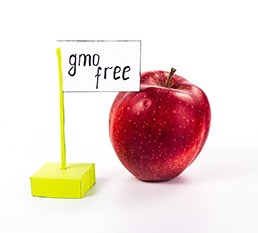
In the U.S., activists have sought labeling, but have enjoyed mixed results at state and federal levels. Connecticut and Maine legislatures have passed labeling laws, while California voters rejected a ballot initiative to require GM food labeling there. In the case of the California vote, familiar brands from Big Food, ranging from Monsanto and Cargill to Pepsico and Hershey, spent millions on advertising to convince that state's residents to vote the measure down. Twenty more states are still considering the labeling question.
Pro-GMO advocates fear that consumers will be scared off by labels identifying genetically modified foods, but polling suggests that Americans favor labels. A 2013 New York Times survey reported that 93% of respondents want GMO ingredients labeled on their foods. A Rutgers’ study that same year, however, found that when asked an open-ended question about what kinds of information consumers wanted to see on food labels that isn't currently listed, only 7% mentioned genetic modification. While the results in the voting booth have been mixed, more consumers are voting with their wallets. Sales of GMO-free products are gaining market share.
"If you're framing this as a debate about technology, you're missing the bigger picture," says Scott Faber, vice president of governmental affairs with the Environmental Working Group, a public health advocacy group in Washington, D.C. "It's about what consumers are entitled to know, broadly, about their food."
U.S. and Europe: Trading Commodities, Or Just Views?
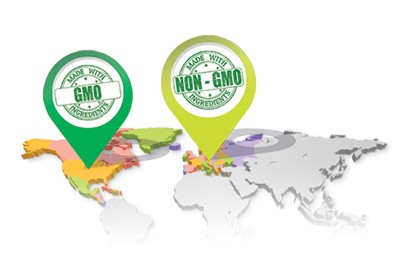
The U.S. and the European Union are presently hammering out an enormous free trade agreement, but differing opinions about genetically modified foods are among the issues slowing progress. The twenty-eight nations of the E.U. largely ban GM foods, except in certain products. If the E.U. refuses to give ground on its current regulations, that effectively closes the door on much of the corn, soybean, sugar beet and cotton grown in the U.S., where crops genetically modified for resistance to disease and drought are commonplace. That doesn't mean there are no genetically modified crops growing in Europe, however. A small part of Spain's corn crops are genetically engineered, for example, and other nations do grow GM crops for animal feed. So far, German chancellor Angela Merkel has indicated that the E.U. plans to continue to defend its current restrictions.
In Europe, all genetically modified food is labeled, unless the relevant ingredients amount to 0.09% or less of the total ingredients. To date, the U.S. has required no labeling of GM foods, taking the stance that genetically modified foods aren't materially different from their non-modified counterparts. Genetically modified foods already appear in processed foods, ranging from salad dressing to cereal, in American supermarkets and have for more than a decade.
The Appeal of GMO
So what kind of appeal does genetically modified food hold for U.S. consumers? The short answer is "not much" so far. The FlavrSavr tomato was not a great commercial success, and concerns about "unnatural" foods create significant barriers to direct entry into consumer markets in many countries, not just Europe and the U.S.
Instead, seed companies have been targeting a different market: growers. From the growers' standpoint, tinkering with a plant or animal's genome to impact yield or hardiness—resistance to disease, adverse growing conditions or pests—improves profits. Some 30 traits are currently engineered into commercial crops, the most popular of which confers resistance to insects, tolerance to herbicides, or both traits together. By 2012, genetically engineered soybeans, maize, cotton and canola accounted for nearly all of the 170 million hectares planted with genetically modified crops worldwide, most of which were grown in the U.S., Brazil, Argentina, Canada and India.
Genetically engineered crops hold some environmental appeal for farmers, too. Monsanto encouraged growers to change their practices from using a range of herbicides and plowing, to using glyophosate (sold commercially as Roundup), its own herbicide, which kills a range of weeds with less toxic exposure for the farmer or wildlife. Plowing depletes topsoil and releases carbon dioxide. On balance, herbicide-resistant crops have reduced the amount of herbicide needed to control weeds. However, overconfidence in a single agent, rather than instituting more sustainable practices, has permitted resistance to that agent to develop.
Herbicide Tolerance: Superweeds and Patents

By the late 1990s, American cotton growers commonly grew an herbicide-resistant strain of genetically modified cotton. Its tolerance for glyophosate allowed widespread use of this chemical agent to kill weeds. In 2004, however, glyophosate-resistant Palmer amaranth, a weed that competes very successfully with cotton, popped up in one Georgia county. Seven years later, it had spread to 75 more counties. Throughout these years, Roundup manufacturer Monsanto ran ads suggesting that resistance to its herbicide was unlikely if glyophosate was applied properly. Studies cited in the ads received criticism that the company’s field studies were too small to produce much glyophosate resistance in the first place, regardless of farming practices.
Resistance to herbicides among weeds is very similar to resistance to antibiotics among pathogens. A recent study by Penn State plant ecologist David Mortensen predicted that herbicide use will rise from 1.5kg per hectare in 2013 to more than 3.5kg per hectare in 2025—a rise directly attributable to herbicide-tolerant GM crop use. Big Agriculture is developing new herbicide-resistant crops for use with different weed killers, and weed scientist John Gressel of Weizmann Institute of Science in Rehovot, Israel says that abandoning herbicides altogether is impractical.
Genetic pollution, or the unwanted spread of traits from one species to another, of all wild-type plant strains, including weeds, is a concern. One genetic strategy to combat the problem is called “The Terminator” by its critics. GM strains with this trait would fail to produce fertile seeds, making the traditional practice of laying aside seeds for planting in the next growing season unachievable. Instead, farmers would be forced to buy new seeds every year. Some biotech companies have promised not to use this type of technology protection despite the fact that it could be a useful tool to combat genetic pollution. Another variation on the Terminator theme has been dubbed the “Exorcist System”, which allows fertile seeds, but with all GM DNA spliced out of it.
When GMO Crops Act Locally
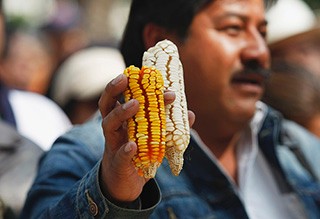
A few years ago, environmentalist and feminist activist Vandana Shiva spoke out about the "genocide" of Indian farmers at the hands of Big Agriculture and its distribution of genetically modified cotton seeds. In fact, the suicide rate within this group hovers around 20,000 per year, because farming can be a very difficult way to make a living in India, regardless of GM crops. Rural farmers often struggle with a credit burden from local lenders. When Monsanto-produced Bt cotton was introduced, some local distributors mixed the more expensive Bt cotton seeds with those for conventional cotton (the GM seeds were five times as expensive as the local hybrids) and then sold the mixture as if it were entirely the Bt variety. There was also a great deal of misinformation about how to use the Bt cotton, and the combination of costs and confusion resulted in financial losses for the already cash-strapped farmers.
According to Matin Qaim of Georg August University in Gottingen, Germany, Bt cotton now represents 90% of the cotton grown in India. In his study of 535 Indian cotton-farming households in central and southern India, he found that yields grew 24% between 2002 and 2008, and farmers' profits rose 50% during that time. Environmental anthropologist Glenn Stone is among this study's critics. He says the short spans of time studied, during the early years of Bt cotton introduction into India, biases the study toward the wealthier, more educated farmers who could afford the seeds. These farmers could also afford to nurse the crops along with more care and attention. Now, he says, the problem is that Bt cotton is so ubiquitous in India that there isn't enough conventional cotton to use as a control in any rigorous study. Qaim maintains that his study already controls for the biases described by Stone.
Meanwhile, in the mountains of Oaxaca, Mexico, a different sort of cultural impact is in play for growers of maize. In this region, maize holds religious significance in the local culture, and GM crops are not approved for commerical production. Consequently, when Berkeley microbial ecologist David Quist published the surprising results of his genetic analyses in 2002, namely the presence of a segment associated with Monsanto's glyophosate-tolerant and insect-resistant strains, a media frenzy descended upon Oaxaca. Theoretically, GM corn was imported from the U.S. for consumption and then planted by farmers who didn't know that the corn was transgenic.
According to Elena Alvarez-Buylla, molecular biologist at the National Autonomous University of Mexico in Mexico City, the spread of transgenes into local maize varieties will change the look and taste of these varieties, traits that are extremely important to local farmers.
"Most of the scientific community doesn't understand the depth of the emotional and cultural affiliation maize has for the Mexican population," says Kevin Pixley, crop scientist and director of the genetic resources program at the International Maize and Wheat Improvement Centre in El Batan, Mexico.
Since that time, studies attempting to replicate Quist's findings in the region have produced mixed results. Scientists on both sides of the argument agree that sampling differences can lead to discrepancies in transgenic detection. In other words, it matters which fields samples come from. The debate continues while the Mexican government decides whether or not to allow Bt maize (with the same introduced genes as the cotton in India) for commercialization.
World Hunger

Probably the most significant attraction of genetically modified food is the hope that it will help combat world hunger. Proponents of GM foods say that to feed the anticipated nine billion-person world population of 2050 adequately, world agriculture will need crops genetically engineered to resist pests, drought, weeds and other poor conditions. Andrea Roberto Sonnino, chief of research at the U.N. food agency, said that to feed the projected population, food production will need to increase by 60%. He maintains that this growth will have to come from increasing yields because there is little room to bring new land into agricultural production. Of individual genetically modified foods assessed as safe, he says, "It's an opportunity that we cannot just miss."
Some experts, like Doug Gurian-Sherman, senior scientist for the food and environment program at advocacy group Union of Concerned Scientists, question the utility of GM foods, however. According to him, strains engineered in the 1990s for drought or pest resistance have only modestly impacted yields. Gurian-Sherman favors conventional crossbreeding or cross-pollinating, plus improved farming methods as they are more economical. He says, "Overall, genetic engineering does not get nearly the bang for the buck" as these less expensive conventional methods of genetically modifying foods.
So far, GMO to solve world hunger just hasn't panned out, in part because Big Agriculture hasn't targeted the staple crops grown by much of the developing world. Instead, other GM researchers are working on crop-industry giants’ neglect. For example, Herve Vanderschuren of the Swiss Federal Institute of Technology in Zurich and his team are working on disease-resistant cassava. Casava is a staple crop in the developing world, and Vanderschuren’s team has been able to incorporate disease resistance genes from one naturally resistant variety into another variety that is resistant to a different virus. Vanderschuren embraces this kind of local adaptation, poised for field testing, but a project of this magnitude lacks appeal for corporations because plants like cassava are not sold worldwide.
Other GM crops are slated for entry into world markets, including “Golden Rice”, fortified with beta-carotene and developed for East Asian markets. Similarly, bright orange bananas offering iron and beta-carotene may reach the African diet in places like Uganda, where this conventional fruit is a staple. In Africa, however, public opinion about GM foods is still a potential barrier to their widespread adoption, with some countries turning down food aid containing genetically modified foods.
Can GMO Be Made More Palatable To Consumers?
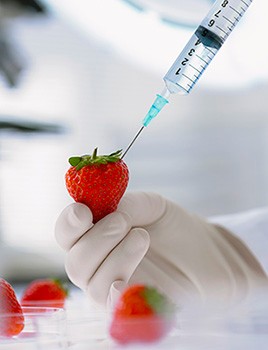
Much of the current research into genetically modified foods focuses on having a softer touch with public fears about genetic engineering and what is “natural”. To this point, researchers like Ralph Scorza, plant scientist at the Appalachian Fruit Research Station in West Virginia, are studying a different technique than the traditional gene guns.
Scorza's work focuses on plum trees that have been genetically modified to flower earlier and continuously by inserting genes from the poplar tree. The new plum tree variety can survive only in greenhouses, but it speeds up the rate at which conventional crossbreeding can occur. Using this method, traditional techniques to breed-in desired traits like disease resistance takes only a few years, as opposed to decades. Scorza and his colleagues are using this “FastTrack” method of breeding to crossbreed in resistance to the plum pox virus and to increase the sugar content of the fruit. Once the desired traits have been bred into the trees' genome, the transgenes that drive flowering can be bred out, leaving a modified tree that is not technically GM, a condition U.S. regulators have already indicated they will evaluate differently than GM organisms containing transgenic material. A technicality, perhaps, but the hope is that this method may alleviate public concerns about GM foods.
Ultimately, however, genetically modified foods may be in our future regardless of public concerns. Biotechnologist Anastasia Bodnar of Biology Fortified, a nonprofit GMO advocacy group in Middleton, Wisconsin, observes that the barrier to entry for genetic engineering is pretty low. Small-scale experiments in garages and basements happen with bacteria, and Bodnar feels there is little to prevent these "biohackers" from moving on to more complex organisms.
"It's becoming easier all the time. I think people are pretty hungry for this kind of thing," she says, adding that if the marketplace isn't bringing people what they want from the top down, that we may see them fulfill their demands from the bottom up.